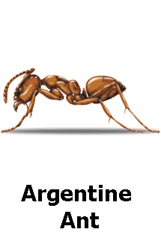


Characteristics
Size: This ant is approximately 1-2 mm in length.
Color: There bodies are brown to black with moderate shininess. Colonies can contain several queens with several thousand workers. Each colony will be divided into smaller colonies. Nests of these spieces of ant are often connected. The smaller colonies can have several hundred to thousands of ants as well.
Behavior: This ant is one of the most difficult ants to control. With the main colonies divided into several smaller sub-colonies, which can include several hundred Queens. Multiple colonies have the tendancey to connect making one giant colony of ants. which can cover several hundred square feet. There main food source is sweet honeydew produced by aphids and mealybugs. Aphids are attracted to vegetation such as fruit trees and certain types of flowers, roses.
Habitat: This native of South America was introduced to Louisiana about 1890 and spread westward to California in 1908. It forms large colonies and numerous nests in soil, debris, or rotting wood and destroys native ants in there territory. It is one of the worst household pests.
Tips for Control: This particular ant is very difficult to control. To accomplish the best control we suggest that Anchor Pest Control perform a through inspection of the ant infestation followed by a regular maintenance program. Introducing control efforts such as these will help accomplish the goal of a pest free environment around your home or business.
You the homeowner can help also, how?: Here at Anchor Pest Control we encourage IPM or Integrated Pest Management. Remove piles of old lumber, bricks or rotting debris from around your home. Perform an exclusion process around your home by repairing any holes or cracks that may allow the ant to enter. You can also consider removing landscaping that produces aphids. The aphid producing plants should be treated to help curve the population.
| BACK TO PEST ID | NEXT PEST |